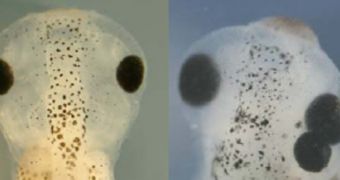They may not produce eyes that have the color you prefer, but researchers have found a method of generating eyes starting with stem cells. At least eye tissues (like retina) could replace damaged parts in cataract, glaucoma, macular degeneration and other ocular conditions that impair vision, leading even to blindness.
The research team at the University of Warwick has found a genetic key for making tadpoles grow three eyes.
"If you knew all the genes, and how to turn them on, that you needed to make an eye, you could start with very early embryonic cells and turn on all the right genes and grow an eye in a dish," said lead researcher Nicholas Dale, a neuroscientist at the UW.
"What I think is the more realistic possibility is to make precursor cells for different bits of the eye, which could then be transplanted and differentiate in-situ to replace damage to the retina or the lens or iris," Dale told LiveScience.
The amphibian genes controlling eye development, called Eye Field Transcription Factors (EFTFs), had been previously discovered but how they are activated was unknown. Now it appears that a nitrogen-bearing molecule triggers the stages of frog eye development.
"The mechanism probably also applies to humans and other animals with eyes," wrote the authors. The team found the "eye starter" while studying the role of "ectoenzymes" from the cells' surface to the muscle development in the African clawed frogs (Xenopus).
When frog embryos made of only 8 cells were exposed to ectoenzymes, wonky eye development resulted. But when these enzymes were applied to cells generating the head, the tadpole grew one extra eye (and thus a three eyed animal resulted). When developing body cells exposed to the ectoenzyme, a supplementary "ectopic" eye grew on the side, abdomen or even on the tail.
The enzyme appeared to induce a massive turn of the energy-carrying molecule ATP into ADP, triggering an embryo's eye-developing genes.
In humans, mutations of the human type of this enzyme provoke extreme head and eye malformations.

 14 DAY TRIAL //
14 DAY TRIAL //